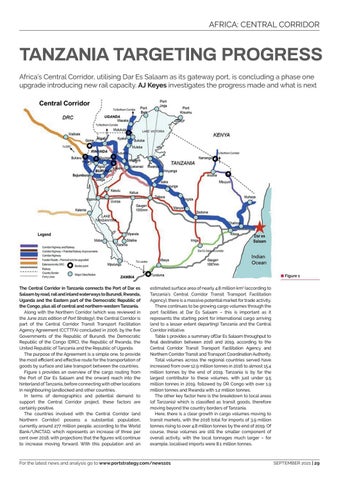AFRICA: CENTRAL CORRIDOR
TANZANIA TARGETING PROGRESS Africa’s Central Corridor, utilising Dar Es Salaam as its gateway port, is concluding a phase one upgrade introducing new rail capacity. AJ Keyes investigates the progress made and what is next
8 Figure 1
The Central Corridor in Tanzania connects the Port of Dar es Salaam by road, rail and inland waterways to Burundi, Rwanda, Uganda and the Eastern part of the Democratic Republic of the Congo, plus all of central and northern-western Tanzania. Along with the Northern Corridor (which was reviewed in the June 2021 edition of Port Strategy), the Central Corridor is part of the Central Corridor Transit Transport Facilitation Agency Agreement (CCTTFA) concluded in 2006, by the five Governments of the Republic of Burundi, the Democratic Republic of the Congo (DRC), the Republic of Rwanda, the United Republic of Tanzania and the Republic of Uganda. The purpose of the Agreement is a simple one, to provide the most efficient and effective route for the transportation of goods by surface and lake transport between the countries. Figure 1 provides an overview of the cargo routing from the Port of Dar Es Salaam and the onward reach into the hinterland of Tanzania, before connecting with other locations in neighbouring landlocked and other countries. In terms of demographics and potential demand to support the Central Corridor project, these factors are certainly positive. The countries involved with the Central Corridor (and Northern Corridor) possess a substantial population, currently around 277 million people, according to the World Bank/UNCTAD, which represents an increase of three per cent over 2018, with projections that the figures will continue to increase moving forward. With this population and an
estimated surface area of nearly 4.8 million km2 (according to Tanzania’s Central Corridor Transit Transport Facilitation Agency), there is a massive potential market for trade activity. There continues to be growing cargo volumes through the port facilities at Dar Es Salaam – this is important as it represents the starting point for international cargo arriving (and to a lesser extent departing) Tanzania and the Central Corridor initiative. Table 1 provides a summary ofDar Es Salaam throughput to final destination between 2016 and 2019, according to the Central Corridor Transit Transport Facilitation Agency and Northern Corridor Transit and Transport Coordination Authority. Total volumes across the regional countries served have increased from over 12.9 million tonnes in 2016 to almost 15.4 million tonnes by the end of 2019. Tanzania is by far the largest contributor to these volumes, with just under 9.5 million tonnes in 2019, followed by DR Congo with over 1.9 million tonnes and Rwanda with 1.2 million tonnes. The other key factor here is the breakdown to local areas (of Tanzania) which is classified as transit goods, therefore moving beyond the country borders of Tanzania. Here, there is a clear growth in cargo volumes moving to transit markets, with the 2016 total for imports of 3.9 million tonnes rising to over 4.8 million tonnes by the end of 2019. Of course, these volumes are still the smaller component of overall activity, with the local tonnages much larger – for example, localised imports were 8.1 million tonnes.
For the latest news and analysis go to www.portstrategy.com/news101
SEPTEMBER 2021 | 29














